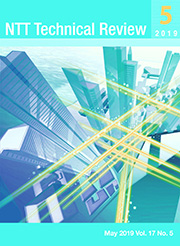
You need Adobe Reader 7.0 or later in order to read PDF files on this site.
If Adobe Reader is not installed on your computer, click the button below and go to the download site.

|

View from the Top
-
 Katsuhiko Kawazoe, Senior Vice President, Head of Research and Development Planning, NTT Katsuhiko Kawazoe, Senior Vice President, Head of Research and Development Planning, NTT

Overview
The NTT laboratories heretofore have focused on research supporting NTT’s own services and systems. However, their strategy has been shifted to the promotion of the B2B2X (business-to-business-to-X) model and now emphasizes value creation with partner companies. What is the mindset at the NTT laboratories to advance research and development (R&D) with the aim of creating innovation for people to live their lives more affluently and in a more natural manner? Katsuhiko Kawazoe, Senior Vice President and the head of Research and Development Planning, NTT, was asked about his attitude toward R&D that will transform the world.
Feature Articles: Ultrahigh-speed Transmission Technology to Support High-capacity Communications Infrastructure of the Future-
 Ultrahigh-speed Transmission Technology for Future High-capacity Transport Networks Ultrahigh-speed Transmission Technology for Future High-capacity Transport Networks

Abstract
Ultrahigh-speed transmission technologies in radio and optical fiber transport systems are essential to accommodate the ever-increasing demand for bandwidth in future network infrastructure. Advanced digital modulation/demodulation techniques as well as ultrahigh-speed front-end integration technologies are optimized to fully exploit the characteristics of different types of transmission media such as air and optical fiber, considering novel degrees of freedom such as space division multiplexing. This article introduces state of the art research and development that achieves ultrahigh-speed communications at speeds of over 1 Tbit/s per carrier (over a hundred times the current speed) in both optical fiber transmission and radio transmission.
-
 Ultrahigh-speed Optical Communications Technology Combining Digital Signal Processing and Circuit Technology Ultrahigh-speed Optical Communications Technology Combining Digital Signal Processing and Circuit Technology

Abstract
This article introduces ultrahigh-speed optical communications technology that achieves the optical transport networks needed to support an advanced information society. Most data traffic is carried on the Ethernet; 400G Ethernet has recently been standardized, and discussions have also started on standardizing signal speeds in excess of 1 Tbit/s. This technology is used to economically transmit high-speed client signals such as Ethernet signals on optical fiber networks. The combination of advanced digital signal processing and ultrahigh-speed circuit technology can greatly improve the speed and quality of optical signals and is expected to result in cost-efficient ultrahigh-speed optical communications at rates in excess of 1 Tbit/s per channel.
-
 Low-noise Amplification and Nonlinearity Mitigation Based on Parametric Repeater Technology Low-noise Amplification and Nonlinearity Mitigation Based on Parametric Repeater Technology

Abstract
Digital coherent technology has advanced greatly in recent years. Further enhancement of its potential will require a breakthrough in both electrical digital signal processing and innovative technologies that exploit the coherency of light. In this article, we describe repeater technology that uses optical parametric amplification (OPA) to minimize degradation in the signal-to-noise ratio in optical transport systems. OPA can potentially achieve low-noise amplification and mitigate nonlinear impairments.
-
 Ultrahigh-speed Optical Front-end Device Technology for Beyond-100-GBaud Optical Transmission Systems Ultrahigh-speed Optical Front-end Device Technology for Beyond-100-GBaud Optical Transmission Systems

Abstract
To support sustainable progress of optical communications, intense research and development (R&D) is being conducted to expand the transmission capacity per channel (transmission capacity per wavelength). Beyond-100-GBaud high-symbol-rate optical transmission technology is now attracting a great deal of attention for its use in constructing future cost-effective optical transport networks. This article introduces recent trends and challenges in optical communications and presents NTT°«s recent R&D in ultrahigh-speed optical front-end device technology for beyond-100-GBaud systems.
-
 Toward Terabit-class Wireless Transmission: OAM Multiplexing Technology Toward Terabit-class Wireless Transmission: OAM Multiplexing Technology

Abstract
NTT is researching and developing technology with the aim of achieving terabit-class wireless transmission that achieves the next generation of 5G (fifth generation). In particular, we are investigating orbital angular momentum (OAM) multiplexing transmission technology utilizing the OAM of electromagnetic waves as a new spatial multiplexing technology capable of transmitting multiple radio waves at the same time using the same frequency band. In an experiment on OAM multiplexing transmission using the 28-GHz band, we successfully demonstrated the world°«s first 120-Gbit/s wireless transmission. This article introduces the details of this technology.
Regular Articles-
 Recent Progress in Applications of Optical Multimode Devices Using Planar Lightwave Circuits Recent Progress in Applications of Optical Multimode Devices Using Planar Lightwave Circuits

Abstract
The optical propagation mode—the electromagnetic field distribution of light propagating through a waveguide—is attracting attention as a new degree of freedom of light and is expected to provide new functions and improved optical characteristics in optical devices and systems. In this article, we introduce optical device technologies that utilize the optical propagation mode in an integrated optical waveguide component called a planar lightwave circuit.
Global Standardization Activities-
 Standardization Efforts of International Electrotechnical Commission Related to Surge Protection Components, and Receipt of METI Minister°«s Award Standardization Efforts of International Electrotechnical Commission Related to Surge Protection Components, and Receipt of METI Minister°«s Award

Abstract
An International Electrotechnical Commission (IEC) international standard for surge isolation transformers (SITs) for communications use has been established based on a proposal from Japan. SITs are components featuring high insulation-breakdown voltage and impedance. They reduce lightning surges to a small voltage level so there is no effect on protected equipment, while simultaneously blocking a common mode noise loop. They provide excellent protection for the DC (direct current) SELV (safety extra-low voltage) circuit on the secondary side in information and communication technology equipment. This article introduces international standardization activities related to SITs at IEC and discusses associated technology.
Short Reports
External Awards/Papers Published in Technical Journals and Conference Proceedings
|











